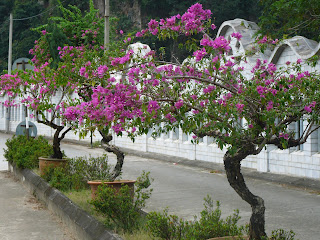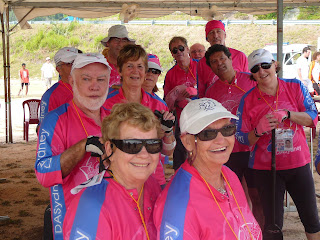In fact, I was quite happy to have an excuse to head back to Shamian because it's a cheerful place, so I leapt on a train Saturday and set off for : "Yellow Sands" subway. Did I make the obligatory sarky remarks about vanished glories last time I blogged on Shamian?

Anyway, this is the vision from the pedestrian overpass between the subway station and Shamian. I'm thinking the last time the sands were yellow here was at least 300+ years ago.
However, I did find some yellow...
 Of course there are things you expect to see in China, which are what people call "the real China" but is actually just one particular memorialised part of it. Annoyingly, no matter how much I editorialise in my mind about this, I am still very pleased so see a man on a bicycle carrying bananas. Perhaps it's the aesthetics of it all - they were VERY yellow.
Of course there are things you expect to see in China, which are what people call "the real China" but is actually just one particular memorialised part of it. Annoyingly, no matter how much I editorialise in my mind about this, I am still very pleased so see a man on a bicycle carrying bananas. Perhaps it's the aesthetics of it all - they were VERY yellow. Note, Shamian, another couple falling prey to the evil wedding photographer.
Note, Shamian, another couple falling prey to the evil wedding photographer.it took a little bit of map & compass reading to find the culture park, because Guangzhou's road system is 3 dimensional and it isn't completely clear from the maps which roads go under or over which other roads.
But on the way there I observed that I was in the garment district - another garment district, not the one in the north near the old railway station.
 Actually, no bundles in this shot...
Actually, no bundles in this shot...This picture should give you an idea - the bundles are packages of clothes from the wholesalers, typically 2 or 3 items in a range of sizes. If your shop needs more than one bundle, then someone will be trolleying it (centre) to you. And if you aren't in the business of selling clothes here, then you're in the business of wearing them (girls, left & right). And this is a quiet spot of the road where I could pause to get the camera out.
 One entrance to the market
One entrance to the marketThe hub of all this is a market, I guess mainly wholesale, but I'm sure possible to do retail as well.
The place is surrounded by wrapped bundles of clothes, in piles, unattended but labelled, waiting for either delivery or collection. I am sure it all works, but it's hard to believe looking at it.
The market is surrounded on 3 sides by the fashion business, and on the 4th - Culture Park. Hmm. So behind Culture Park is a fashion district. And somewhere in this fashion district is a shop that sells B&W film. What's your guess - is the only non-clothing shop in the district going to stand out or be invisible?
I was fairly confident it would be the latter, but nothing daunted, map & compass in hand, I set out to scour the area semi-systematically. I found every conceivable button, braiding, tassel, elastic, banding, coat hanger, mannequin, fastener, bead, beading, sequin shop. Not just shops, streets of shops. Let's say, at least 50 button shops - and I must have missed some. I found a lot of restaurants all jam-packed. I found people selling polystyrene boxes of food prepared in their kitchen - food that in some cases looked better than at least one of my local restaurants - I found people drinking beer from teacups. I didn't find a film developer. Apart from that small defect, it is a really buzzy part of town.
 Beats any terrace windows in Newtown
Beats any terrace windows in NewtownAnd, not without architectural charm either.
By this stage I'd moved so far away from the culture park that I'd pretty much given up on finding film shops. But I was having a good time exploring, and crucially, I wasn't lost, so I thought I'd just keep zig-zagging my way North until the subway appeared or my feet gave up the ghost.
Abruptly - as in, cross one street - I found that I was in the printing district. if you wanted to start a design business here, you could sit in the street on a couple of milk crates with a laptop & a customer. When you had the design ready you could go & buy the paper, get the papershop to deliver it to the printer next door, who could pop around the corner to get the ink, or if required, buy a new machine for a new process. Naturally, if there were any problems, spare parts, electricians and engineers are at hand. This is another whole district devoted to one industry: in fact mainly driven by the advertising printing for all the clothing shops next suburb South. Mind you, I'm not completely sure about the economics of all this. There were an awful lot of people asleep in their shopfronts.
Equally suddenly, I turned a corner into the toy district. And about 200 metres along the main road, that turned into the homewares district.
 And then a cathedral. I almost didn't see it because it was impossible that it should be there. you could have videotaped me for a paradigmatic image of "double-take". It's just there. Not a single foreshadowing sign for tourists or dislocated worshippers. However, I guess this is how a mediaeval city worked - districts organised by crafts and a cathedral in an attention grabbing location. Not that I want to imply that Guangzhou is mediaeval, more that patterns of urban geography are repetitive and re-emergent. I wonder how much of the patterning here is organic and how much planned?
And then a cathedral. I almost didn't see it because it was impossible that it should be there. you could have videotaped me for a paradigmatic image of "double-take". It's just there. Not a single foreshadowing sign for tourists or dislocated worshippers. However, I guess this is how a mediaeval city worked - districts organised by crafts and a cathedral in an attention grabbing location. Not that I want to imply that Guangzhou is mediaeval, more that patterns of urban geography are repetitive and re-emergent. I wonder how much of the patterning here is organic and how much planned?Anyway, the day's mission was to develop a film and by now it was pushing 3 o'clock. As it happens, I found the 2nd hand camera district a while back - which curiously shares its suburb with the fabric markets, the one fashion component I hadn't seen all day. To further demonstrate the estrangement between the fabric markets & the clothes markets, it's not even a close walk. And the tailors in the fabric district are slowly shifting over from clothes to curtains for the new apartment buildings. Howsomesoever, it seemed like a fair bet that where there were 2nd hand cameras, there would be a B&W film developer. And so there was. I wonder how the pictures will turn out? That's an emotion you don't get with a digital camera...































